Podcast
Questions and Answers
What is the main difference between fast pyrolysis and slow pyrolysis?
What is the main difference between fast pyrolysis and slow pyrolysis?
- Bio-oil production
- Heating rate (correct)
- Temperature range
- Residence time
What is the primary product of slow pyrolysis?
What is the primary product of slow pyrolysis?
- Biogas
- Gasification
- Bio-oil
- Biochar (correct)
Which type of pyrolysis is classified into torrefaction and carbonization?
Which type of pyrolysis is classified into torrefaction and carbonization?
- Fast pyrolysis
- Liquefaction
- Gasification
- Slow pyrolysis (correct)
What is the primary factor in selecting a biomass conversion method?
What is the primary factor in selecting a biomass conversion method?
What is the purpose of torrefaction?
What is the purpose of torrefaction?
What is the result of gasification?
What is the result of gasification?
What is the primary difference between torrefaction and carbonization?
What is the primary difference between torrefaction and carbonization?
What is the purpose of liquefaction?
What is the purpose of liquefaction?
At what temperature does the pyrolysis process typically initiate?
At what temperature does the pyrolysis process typically initiate?
What is the primary purpose of gasification?
What is the primary purpose of gasification?
What is the main output of the torrefaction or carbonization process?
What is the main output of the torrefaction or carbonization process?
What is the purpose of burning part of the char in the gasification process?
What is the purpose of burning part of the char in the gasification process?
What is the composition of the evolved products during pyrolysis a function of?
What is the composition of the evolved products during pyrolysis a function of?
What is the typical composition of tar?
What is the typical composition of tar?
What is the primary purpose of heating tar in the gasification process?
What is the primary purpose of heating tar in the gasification process?
What is the heating value of the solid fuel produced through torrefaction or carbonization compared to the raw samples?
What is the heating value of the solid fuel produced through torrefaction or carbonization compared to the raw samples?
What is the primary purpose of the gasifier in the gasification process?
What is the primary purpose of the gasifier in the gasification process?
What is the result of torrefaction on biomass?
What is the result of torrefaction on biomass?
What is the purpose of the cyclone in the gasification process?
What is the purpose of the cyclone in the gasification process?
What is the final stage of the gasification process?
What is the final stage of the gasification process?
What is biochar?
What is biochar?
What is the purpose of drying and grinding the biomass in the gasification process?
What is the purpose of drying and grinding the biomass in the gasification process?
What is the difference between gasification and torrefaction?
What is the difference between gasification and torrefaction?
What is the role of volatiles in the gasification process?
What is the role of volatiles in the gasification process?
Study Notes
Pyrolysis
- Pyrolysis is a thermal degradation or decomposition of biomass to break it down into more valuable products
- The process is initiated at around 200°C, where bonds holding light volatiles are broken and released
Fast and Slow Pyrolysis
- Fast pyrolysis: high heating rate (> 40 k/min), low residence time, and high bio-oil production
- Slow pyrolysis: low heating rate (< 40 k/min), long residence time, and high solid yields (biochar)
Classification of Slow Pyrolysis
- Torrefaction: low operating temperature (max 300 °C) and short residence time (max 2 hrs)
- Carbonization: high operating temperature (min 300 °C) and long residence time (more than 2 hrs)
Thermochemical Conversion Methods
- Liquefaction: produces bio-oil
- Gasification: produces biogas
- Pyrolysis: produces bio-oil, biochar, and biogas
- Torrefaction: produces solid fuel with a higher heating value
Gasification Procedure
- Biomass material is collected, dried, and ground
- Gasifier extracts volatile matter from biomass via combustion in a controlled system
- Output passes through a cooler, filter, and cyclone to remove ashes and produce clean biogas
Pyrolysis Products
- Light gases: H2, CO, CO2, H2O, CH4
- Tar: a black, viscous, and corrosive liquid
- Char: a solid residue mainly containing carbon
Studying That Suits You
Use AI to generate personalized quizzes and flashcards to suit your learning preferences.
Description
This quiz covers the different types of pyrolysis, including fast pyrolysis and slow pyrolysis, and their characteristics, such as heating rate, residence time, and product yields.




